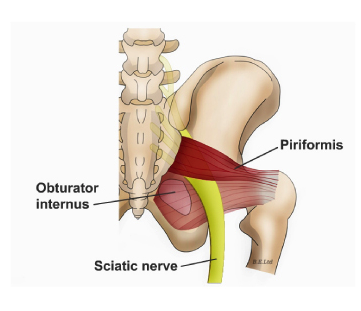PIRIFORMIS SYNDROME
What’s Piriformis Syndrome?

Piriformis syndrome refers to a neuromuscular disorder that occurs when the piriformis muscle, located in the buttock compresses the sciatic nerve. The piriformis muscle, a flat, band-type muscle, which extends from the hip bones to the top of the spine aids in most movements that involve the lower body. This muscle also stabilizes the hip joint and helps to maintain general body balance.
The sciatic nerve, which refers to a large nerve in the lower body extends from the spinal cord to the feet. The sciatic nerve provides sensory and motor functions to the lower extremities and damage to this nerve can lead to inflammation, pain, or numbness in the affected area.
What’s the Causes of Piriformis Syndrome?
Piriformis syndrome generally occurs due to any condition that causes the piriformis muscle to compress or apply pressure to the sciatic nerve. Piriformis syndrome very rarely occurs due to medical conditions associated with abnormal body anatomies such as an unusually formed piriformis muscle or a sciatic nerve that takes an uncommon route to the feet. The most common causes of piriformis syndrome may include:
- Inflammation or irritation of the piriformis muscle due to an injuryMuscle spasms of the piriformis muscle
- Injuries to the piriformis muscle due to a bad fall or a direct hit to the muscle
- Bleeding in the surrounding tissues of the piriformis muscle
- Heavy lifting of objects in an improper form
- Muscle overuse from excessive exercise or other repetitive activities
- Sitting or climbing stairs for extended periods
- What’s the Symptoms of Piriformis Syndrome?
The most common symptom of piriformis syndrome remains sciatica, which refers to a sharp, radiating pain that extends from the lower part of the spine to the legs and feet. The symptoms of piriformis syndrome may turn worse during activities such as walking or running, sitting or driving for extended periods, and climbing stairs. Other symptoms of piriformis syndrome may include:
- Numbness, tingling, or burning sensations in the buttocks that may extend to the legs
- Reduced range of motion of the hips
- Pain in the buttocks and back of the legs that may worsen with prolonged sitting or standing
- Muscle tenderness in the buttocks that may lead to difficulty in sitting
How do Spinal Specialists Diagnose Piriformis Syndrome?
A spinal specialist may request a detailed personal and family medical history of the patient before making a diagnosis. The specialist may also ask questions about any recent fall or trauma that may have triggered the symptoms. A physical examination may occur to check for signs of piriformis syndrome and determine the severity of the symptoms. This physical examination involves asking the patient to stay in a variety of positions to elicit pain in the piriformis muscle. The spinal specialist may recommend imaging tests to make a final diagnosis and rule out other possible conditions with similar symptoms such as a bulging or herniated disc, arthritis, or nerve compression. Imaging tests to diagnose piriformis syndrome may include MRI or CT scans, electromyograms, or nerve conduction studies.
What’s the Treatment Options for Piriformis Syndrome?
Treatment options for piriformis syndrome include surgical and non-surgical treatments. A spinal specialist may only recommend surgery to relieve pressure on the sciatic nerve in severe cases where non-surgical treatment options fail to work. Non-surgical treatment options for piriformis syndrome may include:
- Physical therapy to strengthen the piriformis and increase the range of motion in the hips
- Nonsteroidal anti-inflammatory drugs such as ibuprofen to relieve pain and inflammation
- Ice packs and heat therapy to relieve pain
- Steroid injections
References
Merck Manual (Professional Version). Piriformis Syndrome. (https://www.merckmanuals.com/professional/injuries-poisoning/sports-injury/piriformis-syndrome)
Hicks BL, Lam JC, Varacallo M. Piriformis Syndrome. (https://www.ncbi.nlm.nih.gov/books/NBK448172/) [Updated 18 July 2021]. In: StatPearls [Internet]. Treasure Island (FL): StatPearls Publishing.
American Academy of Family Physicians. Piriformis Syndrome. (https://familydoctor.org/condition/piriformis-syndrome/)
National Institute of Neurological Disorders and Stroke: “NINDS Piriformis Syndrome Information Page.”
